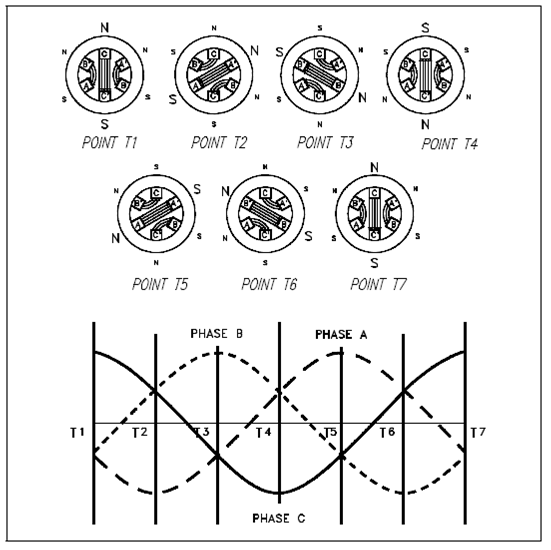Rotation of magnetic field:
For aim of explanation, rotation of the magnetic field is developed in Figure through "stopping" the field at six chosen positions, or instances. Those instances are marked off at 60° intervals on the sine waves representing the current flowing in the three phases, A, B, and C. For the subsequent discussion, whenever the current flow in a phase is positive, a magnetic field will develop a north pole at the poles labeled A, B, and C. Whenever the current flow within a phase is negative, the magnetic field will establish a north pole at the poles labeled A', B', and C'.

Figure: Rotating Magnetic Field
At point T1, the current in phase C is at its maximum positive value. At the similar objects, currents in phases A and B are at half of the maximum negative value. The resulting magnetic field is developed vertically downward, along with the maximum field strength established across the C phase, among pole C (north) and pole C' (south). This magnetic field is aided through the weaker fields developed across phases A and B, along with poles A' and B' being north poles and poles A and B being south poles.
At Point T2, the current sine waves have rotated by 60 electrical degrees. At this point, current within phase A has increased to its maximum negative value. The current in phase B has reversed direction and is at half of the maximum positive value. Like as, current within phase C has decreased to half of the maximum positive value. The concluded magnetic field is developed downward to the left, along with the maximum field strength developed across the A phase, among poles A' (north) and A (south). This magnetic field is aided through the weaker fields developed across phases B and C along with poles B and C being north poles and poles B' and C' being south poles. Therefore, it could be seen in which the magnetic field inside the stator of the motor has physically rotated 60°.
At Point T3, the current sine waves have again rotated 60 electrical degrees from the last point for a total rotation of 120 electrical degrees. At this point, the current in phase B has raise to its maximum positive value. The current in phase A has reduced to half of its maximum negative value, although the current in phase C has reversed direction and is at half of its maximum negative value also. The resulting magnetic field is developed upward to the left, along with the maximum field strength developed across phase B, among poles B (north) and B' (south). This magnetic field is aided through the weaker fields developed across phases A and C, within poles A' and C' being north poles and poles A and C being south poles. Therefore, it could be seen in which the magnetic field on the stator has rotated another 60° for a total rotation of 120°.
At Point T4, the current sine waves have rotated 180 electrical degrees from Point T1 so in that the relationship of the phase currents is identical to Point T1 except which the polarity has reversed. Because phase C is again at a maximum value, the resulting magnetic field established across phase C will be of maximum field strength. Therefore, along with current flow reversed within phase C the magnetic field is established vertically upward among poles C' (north) and C (south). Because could be seen, a magnetic field has now physically rotated a total of 180° from begin.
At Point T5, phase A is at its maximum positive value, that establishes a magnetic field upward to the right. Over, the magnetic field has physically rotated 60° from the last point for a total rotation of 240°. At Point T6, phase B is at its maximum negative value, that will built a magnetic field downward to the right. The magnetic field has again rotated 60° from Point T5 for a total rotation of 300°.
At last, at Point T7, the current is returned to the similar polarity and values as in which of Point T1. Thus, the magnetic field developed at this instance will be identical to that established at Point T1. From this elaboration it could be seen in which for one fully revolution of the electrical sine wave (360°), the magnetic field established in the stator of a motor has also rotated one fully revolution (360°). Therefore, you could see that through applying three-phase AC to three windings symmetrically spaced around a stator, a rotating magnetic field is produced.